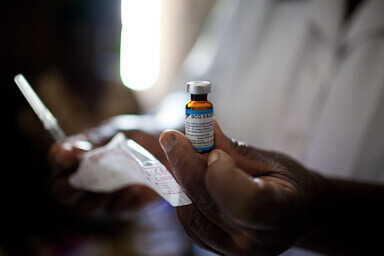In this guest post, Claire Wingfield—product development policy officer at PATH—writes about a new paper she developed for the GHTC that outlines key funding challenges and opportunities for global health research and development (R&D).
The funding landscape for global health R&D is evolving. Significant investments from governments and philanthropic organizations before the financial
crisis helped create robust and promising product portfolios for poverty-related and neglected diseases and conditions. However, in the current financial
climate, budget constraints are threatening this progress. Today, the GHTC is releasing a new paper that examines the implications of this changing environment—in particular, the financing challenges and opportunities facing organizations that
advance the development of new vaccines, drugs, diagnostics, microbicides, and other health products for low- and middle-income countries (LMICs).
Traditionally, the majority of funding supporting nonprofit product development organizations (NPPDs) to develop technologies for LMICs has been grants
from government development agencies—predominately in the United States and Europe—and philanthropies. However, the funding landscape for
NPPDs has changed significantly in recent years, and many organizations are reconsidering their business models and funding structures. In particular,
traditional governmental and philanthropic donors have scaled back their overall investments in NPPDs, and some donors have become more restrictive
in how their money is spent.

- A new paper from the GHTC outlines key funding challenges and opportunities for global health research and development . Credit: PATH.
As a result, NPPDs are pursuing innovative financing models to sustain progress in developing new products and to attract new investment, both to fill
the funding gap and to increase the flexibility of their funding. Across the diverse group of NPPDs we surveyed for the paper, we found common funding
challenges that each is grappling with in this new environment.
- Donor shifts away from core funding to more narrowly restricted funding. Donors are increasingly awarding project-specific funding,
which can only be used for a designated activity, as opposed to core funding that gives NPPDs the ability to support multiple projects at different
stages of development. Because of this shift, NPPDs noted that funding can significantly influence scientific decision making. Each of the NPPDs
interviewed said that this shift away from more flexible core funding toward project-specific funding is their most significant challenge.
- The small number of major funders. Shrinking resources means that NPPDs cannot keep pace with the increased costs
of progressing new health products through large-scale studies. As a result, funding available to NPPDs is shrinking just as promising products
are advancing through the research pipeline into large-scale studies needed to demonstrate safety and efficacy in diverse populations.
- Discordant funder priorities and requirements. As some funders scale back on their support, NPPDs are increasingly seeking out multiple
donors and funding sources. While funding diversification can help provide independence, it can result in the misalignment of funder requirements.
NPPDs with varied funding sources can experience challenges in managing multiple funder requirements, which creates the need for more administration
and staff resources.
- Limited capacity to identify, cultivate, and sustain funding. As NPPDs seek out new funding opportunities, they must invest in a new
configuration of skills—including managing, identifying, and cultivating new sources of support. This involves dedicating additional staff
time, sometimes from researchers, and establishing new systems to cultivate new donor relationships.
NPPDs noted that while the funding environment presents many challenges, there are also new investment and partnership opportunities. To ensure that the
goal of creating cost-effective, culturally relevant, affordable, and accessible products is driving their work, NPPD outlined criteria that can be
used to design and evaluate financing. Specifically, funding mechanisms and donor support should:
- Support a portfolio of products at different stages of development. This ensures that only the most promising products advance through
the research pipeline and allows NPPDs to shift funds to more promising projects. It also ensures that the entire product development lifecycle—from
preclinical through introduction and wide-scale adoption—is funded.
- Provide sustainable funding commitments. Additionally, the duration of funding commitments should be guided by the scientific need.
This will require multi-year funding commitments that align with the timelines of the product development process.
- Support core activities. These activities—such as administrative and facility costs, support activities for advocacy and public
awareness, and the cultivation of new funding sources—are critical to the success of any organization. All funding should include a proportionate
level of support for the overall costs of running the organization or specific program.
- Incentivize new investment. Funding is most effective when it can be used to attract new financial support and other investments.
The more flexible the funding, the better able the recipient is to create opportunities to complement existing investment.
All of the NPPDs noted that exploring new financing models is not new to them but that they must continue to adapt their financing models and explore new
opportunities to respond to an evolving funding environment. Finally, better collaboration among stakeholders—including NPPDs, governments, academia,
foundations, and the private sector—is critical to maximizing R&D funding to improve health and well-being in LMICs.
